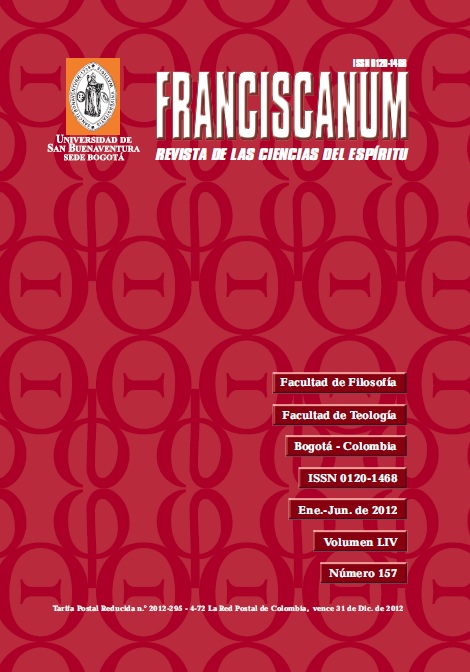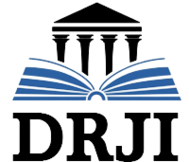This journal provides immediate open access to its content, based on the principle that giving the public free access to research helps a greater global exchange of knowledge.
Therefore, the Creative Commons 4.0 Attribution Attribution - Equal Share (by-sa) License is accepted: The commercial use of the work and the possible derived works is permitted, the distribution of which must be done with a license equal to that regulates the original work.
http://creativecommons.org/licenses/by-sa/4.0/
Along these same lines and in line with the Open Access policy, it is clarified that the authors maintain their rights to articles, without restrictions and, in the same way, they maintain their publication rights, without restrictions. They are only asked to reference the number of the Franciscanum magazine where the article initially appeared.
Abstract
Keywords:
References
Amir-Moezzi, Mohammad Ali (ed.). Dizionario del Corano. Milano: Mondadori, 2007.
Burgat, François. El islamismo en tiempos de Al-Qaida. Barcelona: Bellaterra, 2006.
Campanini, Massimo. Ideologia e politica nell’Islam. Fra utopia e prassi. Bologna: Il Mulino, 2008.
________. L’esegesi musulmana del Corano nel secolo Ventesimo. Brescia: Morcelliana, 2008.
Campanini, Massimo, Mezran, K., (eds.). Arcipelago Islam. Tradizione, reforma e militanza in età contemporanea. Bari: Laterza, 2007.
________. I Fratelli Musulmani nel mondo contemporaneo. Torino: UTET, 2010.
El Corán. Barcelona: Herder, 2005.
El Sayed, Mahmoud Aly, “Simbolismo de lugar y etimología de los nombres en “Hijos de nuestro barrio” de Naguib ”. Anaquel de Estudios Árabes ix (1998), 179-180.
Evertsen Lundquist, Suzanne. “Narrative Theory in Naguib Mahfouz’s The Children of Gebelawi”. En Understanding others. Cultural and Cross-Cultural Studies and the Teaching of Literature, editado por Joseph Trimmer y Tilly Warnock, 213-229. Illinois: National Council of Teachers of English, 1992.
Kassir, Samir. De la desgracia de ser árabe. Córdoba: Almuzara, 2006.
Kepel, Gilles. La revancha de Dios. Cristianos, judíos y musulmanes a la reconquista del mundo. Madrid: Alianza Editorial, 2005.
Lizzini, Olga. “L’angelologia islamica: il Corano e la tradizione”. En Angeli. Ebraismo. Cristianesimo. Islam, editado por Giorgio Agamben y Emanuele Coccia, 1455-1500. Vicenza: Neri Pozza Editore, 2009.
MacDonald, D.B.; Boratav, P.N.; Nizami, K.A.; Voorhoeve, P. “ ”. Encyclopaedia of Islam, Second Edition. Edited by: P. Bearman; Th. Bianquis; C.E. Bosworth; E. van Donzel; and W.P. Heinrichs. Brill, 2011. Brill Online. Universidad De Granada. http://brillonline.nl/subscriber/entry?entry=islam_COM-0191 (Consultada enagosto 1, 2011).
Mahfuz, Naguib. Hijos de nuestro barrio. Madrid: Ediciones Martínez Roca, 2006.
Mernissi, Fátima. El harén político. El Profeta y las mujeres. Madrid: Ediciones del Oriente y del Mediterráneo, 2002.
Najjar, Fauzi M. “Islamic fundamentalism and the intellectuals: The case of Naguib Mahfouz”. Bristish Journal of Middle Eastern Studies 25 (1998): 139-168.
Nietzsche, Friedrich. Sobre la utilidad y el perjuicio de la historia para la vida [II Intempestiva]. Madrid: Biblioteca Nueva, 1999.
________. Humano, demasiado humano. Un libro para espíritus libres. Vol. I. Madrid: Akal, 2001.
________. La ciencia jovial [La gaya scienza]. Madrid: Biblioteca Nueva, 2001.
________. Fragmentos póstumos. Vol. iv (1885-1889). Madrid: Tecnos, 2008.
Pacheco, Juan Antonio. El pensamiento árabe contemporáneo. Rupturas, dilemas, esperanzas. Sevilla: Mergablum, 1999.
Peled, Mattityahu. Religion, my own. The literary Works of . New Brunswick, New Jersey: Transaction Books, 1993.
Prado, Abdennur. El islam como anarquismo místico. Barcelona: Virus editorial, 2010.
Qutb, Sayyid. Justicia social en el islam. Córdoba: Almuzara, 2007.
Ramadan, Tariq. El reformismo musulmán. Desde sus orígenes hasta los Hermanos Musulmanes. Barcelona: Ediciones Bellaterra, 2000.
Roy, Olivier. Genealogía del islamismo. Barcelona: Ediciones Bellaterra, 2000.
Ruiz Callejón, Encarnación. “Hijos de nuestro barrio: la memoria de la humanidad y el diálogo entre culturas”. Pensamiento. Revista de Investigación e Información Filosófica (en prensa).
________. “Hijas de nuestro barrio: la ‘tierra prometida’ y ‘el pueblo elegido’ vistos desde la diferencia”. Ilu, Revista de Ciencias de las Religiones, 16 (2011): 225-246.
________. “Nietzsche y Mahfuz: la historia como enfermedad”. En Miradas a los Otros. Dioses, Culturas y Civilizaciones, editado por Remedios Ávila, Encarnación Ruiz y José Manuel Castillo, y coordinado por José Bernal, 401-428. Madrid: Arena Libros, 2011.
Ternisien, Xavier. Los Hermanos Musulmanes. Barcelona: Ediciones Bellaterra, 2007.
Villegas, Marcelino. La narrativa de Naguib Mahfuz. Ensayo de síntesis. Alicante: Secretariado de Publicaciones Universidad de Alicante, 1991.
Wensinck, A.J. “ ”. Encyclopaedia of Islam, Second Edition. Edited by: P. Bearman; Th. Bianquis; C.E. Bosworth; E. van Donzel; and W.P. Heinrichs. Brill, 2011. Brill Online. Universidad de granada. http://brillonline.nl/subscriber/entry?entry=islam_SIM-3021 (Consultada en agosto 1, 2011).



















